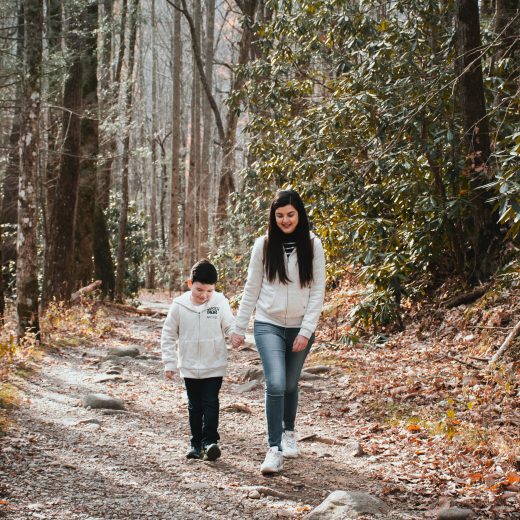The temperature is cooler. The holidays are here. And the new year is approaching. This is the perfect time for you and your family to get outdoors, tune into your bodies, and start to reflect on the new year ahead by practicing some mindful walking. If you’ve never walked mindfully before, here’s some information about what it is, why it is enjoyable and helpful, and how to practice it with your family.
Why Walking Helps
Do you know of the ancient Latin phrase, Solvitur ambulando? It means, “It is solved by walking.” The phrase is a good reminder that even intractable problems can often be worked through by taking a long walk outside. Have you ever had this experience? If not, I encourage you to give it a try. The next time you feel stuck, frustrated, or at a dead end, put your things down and head outdoors. Don’t plan a destination, just let your feet guide you. After a while, you’ll likely notice that your mind and body have settled and that your thinking has shifted a bit. In addition to a myriad of physical benefits, walking often brings new insights and new perspectives. You don’t need to consciously think through your problems to make this happen. Just put one foot in front of the other and get outside.
When you walk, it helps to bring mindful awareness to the sensations you feel in your body and to what you see, smell, hear, and feel outside. This helps ground you in the present moment, so you can take a little break from the chatter going on in your mind or the strong emotions you feel in your body. With mindful walking, the combination of movement, the outdoors, and awareness is quite powerful. When you walk mindfully, not only do you have new insights, but you may begin to feel better in your body and rediscover a sense of joy.
3 Mindful Walking Exercises
Here are some suggestions for how to cultivate mindfulness during your walk. You can practice these suggestions yourself and introduce them to your kids. Kids have an innate drive to move and a natural curiosity of the outdoors. When we help them learn how to use outdoor walking as a coping strategy early on, they may be better able to cope on their own in the future.
1. Engage Your Senses
When you walk, begin to consciously open up your senses. Name 5 things you see. Identify 4 things you hear. Spot 3 things you could touch. Note 2 things you smell. Describe 1 thing you taste.
Find one or two natural objects, such as an interesting plant, or an ant crawling along the ground. Look at each object closely, engage your sense of curiosity, and take in all of its detail, including its texture, color, and shape. This kind of focused attention may inspire a feeling of awe. Even brief experiences of awe have been found to help people find common ground with others and become less extreme in their thinking.
2. Embodiment Practice
As you walk, try these body-oriented practices to release tension and restore the natural alignment of body and mind. Notice if your mood or thinking shifts as you practice.
Part 1: As you walk, imagine your head is like a balloon floating straight up into the sky. Allow this to create length in your spine, and make room in your torso.
Part 2: Breathe and feel the sensations in your body, such as tension or holding in back of your neck or head, the hinge of your jaw, your forehead, or your hip flexors. As you walk, focus on allowing these small pockets of tension to soften and melt. Breathe directly into these areas.
Part 3: Allow your entire spine to spread backwards in all directions. Let your back lengthen and widen as you breathe.
Part 4: Finally, feel your arms and legs lengthen like ferns unfurling.
3. Practice Gratitude
As you walk and take in your surroundings, think of what you are grateful for. Start with one area of your life and then consider it in detail. Perhaps you are grateful for all of the teachers and mentors you’ve had. Think about what they taught you and the unique lessons they imparted. Or maybe you are grateful for family. If this is the case, bring each family member to mind and contemplate how they have supported you or shared themselves with you.
Don’t rush. Let yourself rest in gratitude and feel it in your body. You may find that reflecting on what you are grateful during mindful walking allows you to think more clearly about the present and is a good starting place for thinking about the future.
At Intuition Wellness Center, we specialize in health and wellness services for children, young adults, and their families. If you think you would like some extra support, we’re here for you.
Written by: Debby Urken, LMSW; Child & Family Therapist
Debby Urken, LMSW is a Child & Family Therapist at Intuition Wellness Center in Tucson, AZ. To schedule an appointment with Debby or one of her team members, please fill out an online request.


